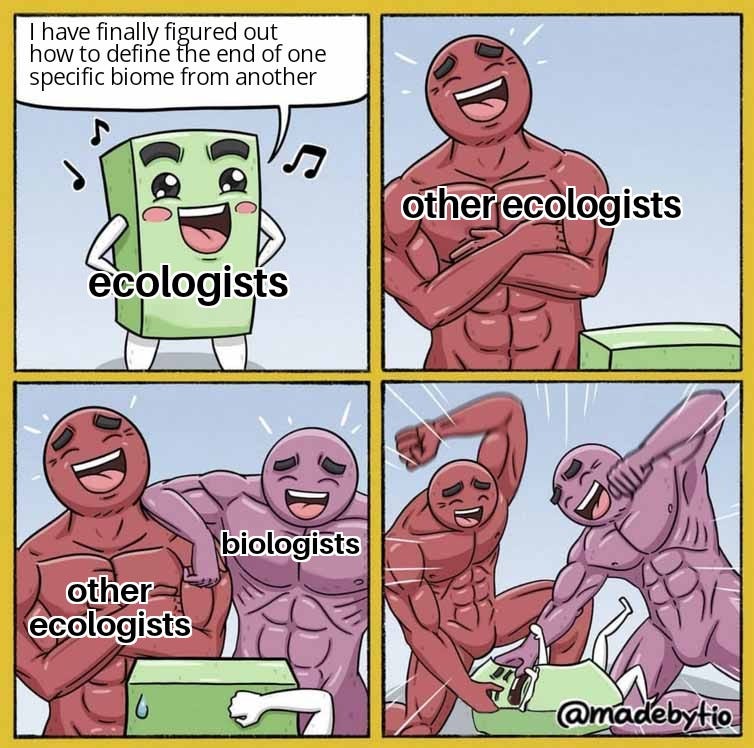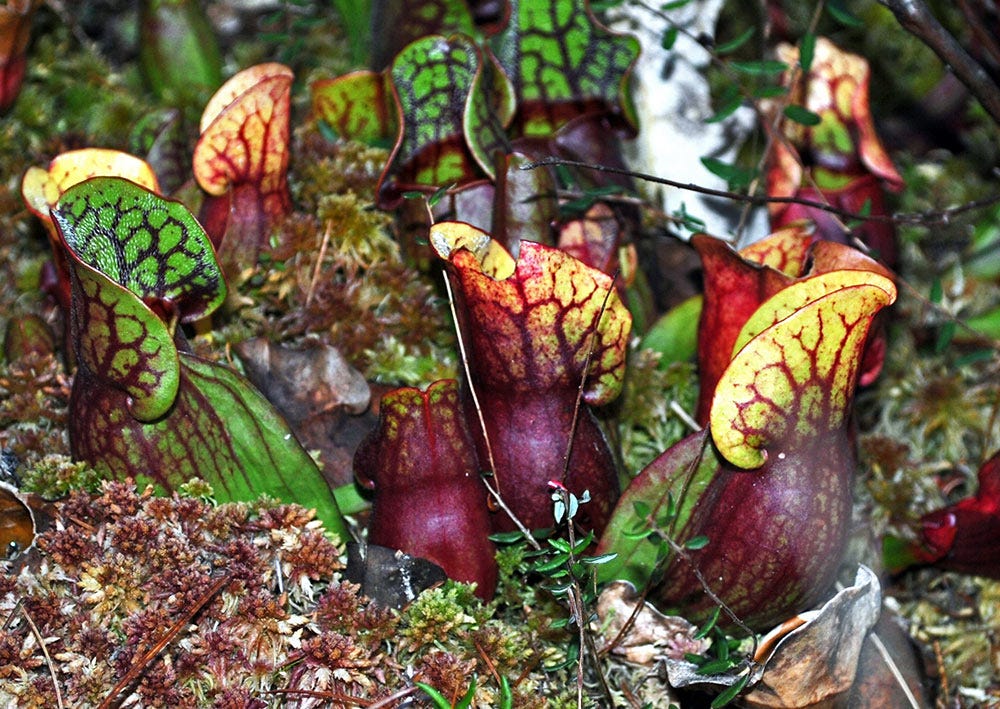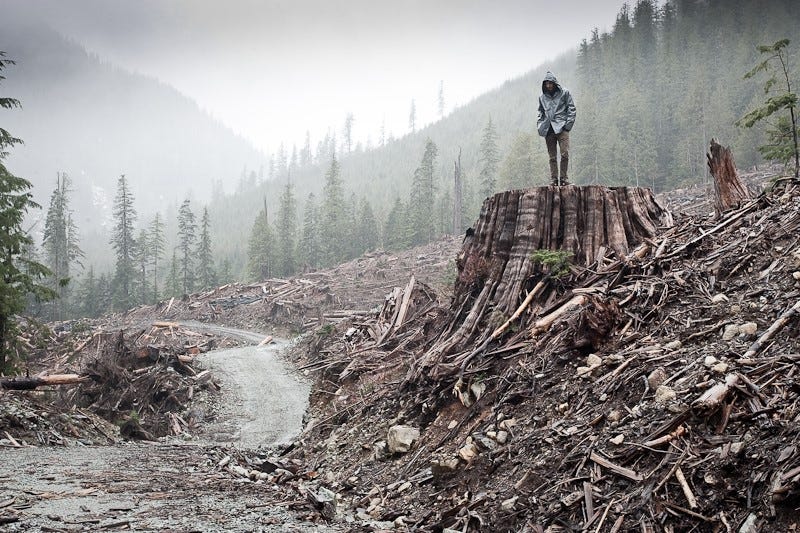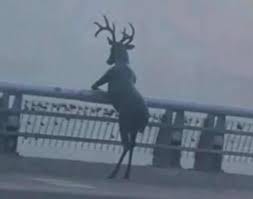Decoding Nature's Matrix: Unveiling the Secrets of Biomes
Exploring plant communities through their construction
With a basic forest ecology background, we can look more closely around the context of localized biome communities and how that helps narrate our conversations around things like water accessibility, foraging opportunities, forest types and successions, as well as how these impact our ability to grow specific foods. By identifying things such as indicator species within a biome, we can use this information to tease out which ecosystem we are surrounded by, which helps narrow down our focus of species diversity, simplifying everything from the types of edible plants which may available to which animals which may exist within the community, pH of soil, and ultimately which plants we can plant with high likelihood of success. This kind of knowledge is integral as we either plan to manipulate the environment around us or simply try to enjoy nature and enjoy the excesses that it has to offer us.
To divide the world in a few ecological zones is a difficult attempt, notably because of the small-scale variations that exist everywhere on earth and because of the gradual changeover from one biome to another can make it hard to create firm boundaries. In this sense, boundaries must be drawn seemingly arbitrarily and their characterization made according to the average conditions that predominate in them. The quote-unquote big picture of defining biomes focuses on three different subject areas as a matrix—latitudinal regions, altitudinal belts, and humidity provinces, all of which are impacted by both annual precipitation and evapotranspiration rates— which is essentially a ratio of how quickly water evaporates versus how much it rains. Even within this context, there are numerous scientists who disagree on where to designate different regions, and which specific indicators are integral in defining those contexts. Needless to say, this complicated endeavor should not be treated as a hard science and more of an Overton window to help narrow your focus of research.
I want to cover a few quick tools that will help you in navigating this process. We had discussed in the piece on complex systems theory that more complex systems were healthier and more anti-entropic, which is good for us and the Earth. Part of complex systems was around the idea of niche or stratification. The more species existed, the more they specialized, and with specialization comes efficiency. This is helpful in understanding our biomes. We had discussed how generalists do exist in order to fill in gaps of the ebbs and flows of availability of resources, but ultimately, if we think from the perspective of nested systems, specialization is a relative thing, right? We think of honeybees, for example, as being generalists, but in reality, they are highly specialized to only eat pollen and nectar from flora that are not wind-pollinated. A bear, in comparison, can eat berries, meat, bark, fish, greens— basically everything. Within the context of insects, honeybees are generalists; within the context of living things, they are very much specialists. So when we start talking about specialization, we have to understand that it’s a very relative term, but the efficiency gains are real, regardless.
In the world of biomes, species such as red maple and red oak are common generalists, and are found across half of the continent. The flip side of this are indicator species, which highlight when biomes have developed to the point of creating enough diversity and specific needs within their communities to be able to have specific plants (usually plants) which exist only in a very specific habitat which support specialist animals and plants. Without these species, the fundamental functions of these ecosystems fall apart. What that looks like and what you might be thinking of are two different things; when I say they fall apart, I mean the things that make that system unique fall apart, not that species won’t continue to survive and even possibly thrive.
The Pine Barrens
I’ll unpack that a bit. Let’s take a look at the pine barrens ecosystem. This ecosystem has evolved in a specific, extreme environment; droughty, sandy, acidic soils with poor water-retaining capacity. They’ve evolved as a fire-dependent savanna with scattered trees, predominantly jack pine. These systems support a number of endemic species that cannot be found anywhere else. Without jack pines, without humans, these ecosystems begin to fall apart. Jack pines are the dominant tree of these ecosystems, providing stability and some canopy, and their survival is dependent on low-temperature burns, which have been provided by humans for centuries. Unfortunately, our lack of burning, paired with invasive species and construction, has destroyed most of the pine barren ecosystems.
Here’s the thing; to the untrained eye, the pine barrens today might look healthier than ever. Driving through Plymouth, Massachusetts, the pine barrens are littered with bright green growth— tall black locusts are scattered across the landscape with thick green grasses following their root structure, enjoying the dappled light. In the fall, neverending rows of green bushes are covered in bright red berries from autumn olive, and birds can be seen picking at the fruits, often one of the last of the season. The thing is, these non-native species are fundamentally changing the ecosystem. Both of these invasive species fix nitrogen to the soil, and moving into this landscape provides endless opportunities for growth, and in the process of colonizing this landscape, they are creating new opportunities for other species to move into the newly nitrogen-fixed soil. On the surface, this seems like a net-positive, right? Adding nitrogen to soils is considered the way to create “healthier” soil, and we even talked about how to do this not too long ago.
This new soil can no longer support the native species which had co-evolved in these uniquely difficult conditions. This unique, highly efficient ecosystem, with dozens of endemic species are losing what little habitat they had left, and the species replacing them have not co-evolved with any species in the region. The birds eat the fruit, but unlike the native fruits that ripen in the fall to provide large amounts of fats before migration, the autumn olive fruits are mostly sugars and don’t help prepare birds for their travels. Birds will eat the fruit for a lack of other options, but in the process the seeds are disbursed, making the species they need struggle even further. On the surface, the system seems healthy. In reality, the system has completely unraveled, and none of the species that move in are providing the necessary habitat for these endemic pollinators like the Pink Sallow Moth, which relies specifically on blueberry bushes and scrub oaks which exist primarily in pine barrens or similar ecosystems.
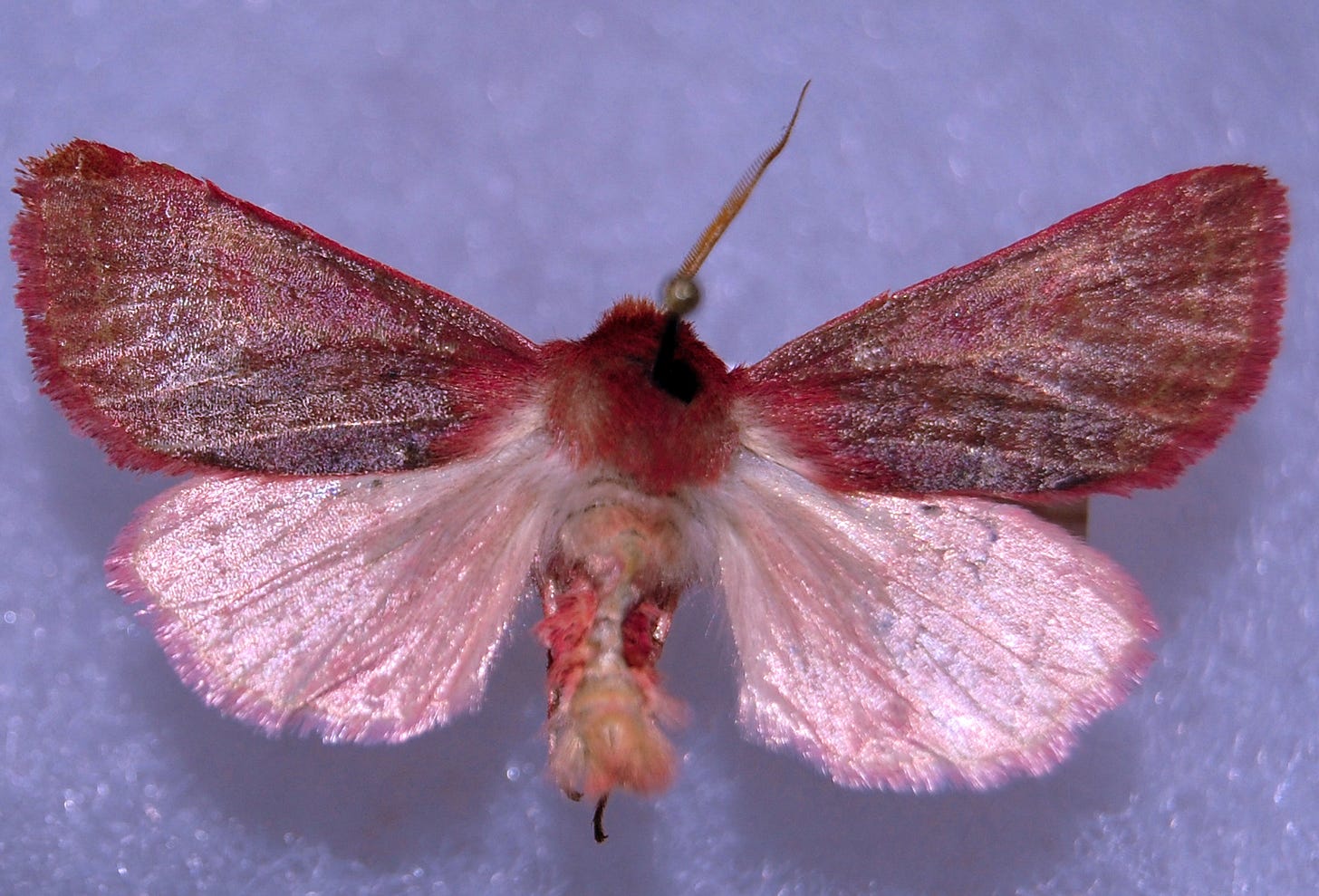
When we reduce the species that can be supported, we lose the efficiency of species like the Pink Sallow moth, which has co-evolved alongside blueberry bushes to maximize the resources available in the ecosystem.
The Pine Barrens, for example, aren’t just home to some unique pollinators, but are a perfect example of how unique ecosystems evolve in remarkable ways. Carnivorous plants evolved to eat insects as their nitrogen source instead of drawing it from the soil - which is why we have endemic carnivorous plants in the pine barrens. If the soil becomes full of nitrogen their unique adaptations don't help them outcompete because their niche basically collapses. 1
This might seem like you’re making a proverbial mountain out of a mole hill, but insects make up more biomass than any other class of animal on the earth— their importance and their ability to exist in diversity for resilience in the face of climate change cannot be understated.2
Back to the Big Picture— Soil
When we speak of all of the different animals and plants within an environment, we are speaking of species richness, which is an indicator of the health of a biome or forest. We had talked about co-evolution and how many species align their needs in order to create positive-positive relationships, where they both benefit, either called mutualism or protocooperation, and when the opportunity for one of those species to enter an ecosystem, the other generally joins as well. The process of developing these specific divisions is called stratification, and the more stratification we see, the more developed a forest will typically be. What we keep seeing in all these discussions regarding nature is the repetition of patterns within the chaos— or rather, as well discussed in the first episode— patterns with chaos within.
Now, I feel like we’re always talking about soil, but we’re going to again in a different format because it’s so integral to the discussion of identifying forests and biomes. When we talk about soil in this context, we are not talking simply about the mineral content and the biology, but the moisture content and the texture from regional variations of specific litter on the ground from the plants and animals. We’ll start with discussing true spodosol soils, which are usually gray in color, with a thin band of black, highly decomposed organic material on the surface. This soil is common in northern coniferous forests because of the heavy needle content, and the soil is usually soft to walk upon. These soils form in sandy materials, under climates where large amounts of water infiltrate into the soil at one or more times of the year. In northern states, that "time of year" is during the snowmelt period, in spring.
Gray-brown spodosol, often called alfisol, is the common soil found beneath eastern broad-leaved deciduous forests. The color is more brown than true spodosol, and the litter layer of dropped leaves is not as thick. The soil is less acidic, and is usually a transition type soil between true spodosol and other regions.
Yellow soil is, well, yellowish on the surface, and grayish yellow below, and is mostly a sandy material with little humus or litter layer. Pine and pine-oak forests are common in these regions.
Red soil, or oxisol, is common in the southeast and is usually an orange-ish color. The litter layer is thin, and is a common soil for southern hardwood forests and southern oak-hickory forests.
Soil is the product of the combined effects of geology, rainfall, temperature and vegetation. The geology is effected by the impacts of glaciation, and the minerals and how they impact chemically with water from rain and snowfall, as well as temperature, which give regional soils their colors.
In the context of that matrix, you can see how that soil structure is delineated here pretty clearly. Each of these soil types both reinforces the species that live on it and is a byproduct of those species that live on it, reinforcing specific communities. This makes sense; species want to create the ideal conditions for themselves, and they tend to grow where conditions are ideal for them. Trippy, right?
Moisture
With that in mind, moisture is a significant factor in our soil as well as our habitat. When we talk about our habitats, it’s worth mentioning that moisture leads to three different habitat conditions; dry— or xeric, wet— or hydric, or in between— mesic. Much like how temperature extremes make niche specialization harder and reduce the potential complexity of ecosystems, moisture content has a similar impact— it is the extremes that inhibit complexity and species— but the species that survive these landscapes, like the Pine Barrens, are some of the most unique examples of biology on the Earth.
What many folks are not aware of within this context is that forest density significantly impacts both humidity & rainfall.3 More density in the forest increases moisture in the air. Much like the soil structure, the forest pushes to reinforce the conditions that it needs to continue to thrive.
Further, it’s important to consider that some indicator species, such as Jack Pine, are indicators of other extreme events, such as fire cycles in regions. Many east coast beach communities have historically been regions of wildfire, and our current management of these landscapes is accelerating their loss, as we’ve discussed previously.
Stratification
Part of identifying our biome and specifically a forest is identifying its age. As we said, more complex systems have more stratification, and generally, in nature more complex systems are older. Using this sense of stratification is helpful in identifying forest age. Looking at what we consider old growth forest, we usually see a well-defined canopy and understory, and dead tree snags will generally be visible. The ground will be also irregular and rolling in its topography from various decomposed stumps and nurse trees. Trees will tend to be larger and spaced further apart, and generally the litter layer on the ground will be extremely thick. Most of the sunlight is captured by the canopy and understory, and the ground level will be quite dark and cool, without too much stuff growing on the ground like grass.4
Younger forests, in contrast, are often dense and full of pole trees— that is, trees that look like poles, as they try to race one another to get to the canopy first. Light often does break through to the surface, but not in large sections, and the litter layer on the ground is quite thin. Usually these forests are rebuilding from a disturbance.
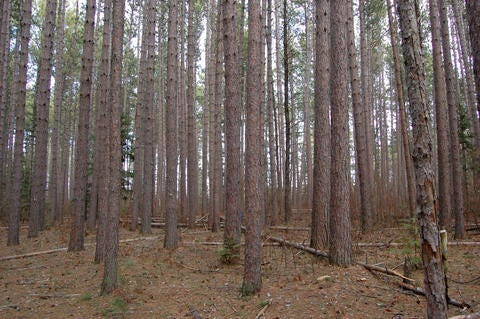
There are ways to figure out what that disturbance was, and can be really helpful in trying to figure out whether you should be concerned about poisons or anything else in your soil. Generally, grazing lands will state fairly natural, but will typically have former shade trees dominating the landscape as the largest tree on the lot, with a full canopy, much larger than the trees around it. There will still be irregular, rolling grounds, and decomposed fallen trees will likely be minimal, since the land was lightly managed. Meanwhile, land used previously for grain or corn monocrops will have been tilled every few years, meaning the land will be pretty flat, the tree age will be uniform, and there will likely be clusters of rocks from the tillage. When land is tilled, rocks are brought up from beneath as new soil is exposed to the air. These rocks are generally dumped at the end of a field, marking the edge of the farmer’s property. However, compared with more intensive annuals; think your typical summer farmer’s market fare, the monoculture field crops are much less substantially managed. Your annual veggie farmer would traditionally till the ground every year, meaning significantly more rocks ending up at the edge of the property, which were usually built into small walls. If you’re from New England, you find these walls— from 2 feet to 4 feet, all over the woods. Further, these soils, because of the extensive erosion from the constant plowing, have sunk considerably, and will likely slope away from the rock walls at a more extreme rate than wheat fields. There are plenty of other markers to look for, with a careful eye, to understand what’s happened to your property. If this stuff interests you, I highly recommend checking out Tom Wessel’s book Reading the Forested Landscape.
In the last piece, we had discussed the importance of humans in developing forests into what is most beneficial for us and creating a sustainable future. Even without our involvement, those same skills we had talked about are valuable in attempting to predict our forest’s future. By identifying the species growing as saplings, we can identify if the trees that cover the canopy will continue to be the dominant species, or if another species appears to be moving in on the territory.
These changes often come at the hands of different habitats nearby, which has a border called an ecotone. These ecotones are usually considered to be shrubby areas with a variety of species from the different forests nearby, and is a transitional area where species interact and compete in a way that otherwise wouldn’t be common. Because of this, ecotones are ideal spaces for things like hunting, where access to more game will be available, and are often some of the most diverse spaces within a forest. Ecotones can run from slim margins to wide transitional spaces with mixes of different forest and prairie types.
Okay, so what’s a biome?
So with that said, what determines a community? A forest is an assemblage of plants and animals coexisting and interacting— together they are an ecological community. Focusing on the United States, communities can vary considerably based on those key markers that we had discussed when attempting to dissect biomes. While no two forests are the same, it is still possible to recognize major regional forest communities. If you attempt to check online to see what biome you live within, you’ll be inundated with various suggestions— some vague and some incredibly specific. Even within those specific bodies you’ll find variation— in the forest ecology episode we had discussed the impacts sun-facing sides of slopes have on the forested landscape, and that plays out on both large and small scales.
Some of what we see in our local forest ecologies has more to do with pioneer practices of clearcutting massive regions than anything related to the natural state of the region itself. As we had discussed in the forest article, oak-hickory forests are the successive state for pine-oak forests, so it only makes sense then that oak-hickory forests are native to regions that have not been moonscaped by indulgent pioneers.
With this in mind, let’s talk about indicator species a bit more. We have talked about indicator species a bit, but it’s worth mentioning that indicator species are incredibly useful when we’re thinking about things like foraging— we can narrow our focus of what to study and learn by understanding the fundamentals of the forest around us. Since we may live in, say, the pine-oak forest, but maybe we are near an ecotone, it’s worth being able to identify those species that help us as a reference point as we try to hunt and eat from the land around us. Or, maybe even from a more selfless perspective, we can use the indicator species to further appreciate the complexities of nature around us.
Indicator species can also speak to the health or diversity of a forest. Going back to the Pine Barrens example, Pink Lady’s Slipper is a unique orchid which can only live where a very specific fungi in the Rhizoctonia genus also exists. Unlike most seeds, their seeds usually don’t have enough food stored to break out of the seed shell, and can only begin to grow when this fungi breaks the seed open. For the early portion of the long-lived plant’s life, the fungi is where most of the plant’s food comes from. Without this specific fungi, the plant cannot exist, and it takes many years before the plant can source food not from this specific fungi, and as many years until it flowers for the first time.5 Seeing a flowering Pink Lady’s Slipper tells you a number of things about the health and stability of that habitat.
We can also learn a lot about the biomass of a forest habitat— which simply means the combined weight of the living organism within the biome. Everyone is familiar with the concept of an apex predator, whether that means a lion, wolf, or a bear. For every major predator, there must be numerous smaller species to sustain him, and in turn even more numerous smaller species for those animals, and at some point we transition from carnivorous animals to herbaceous, and ultimately we find that the foundation of our forest health comes from the plants themselves and how quickly they’re able to generate and store energy from the sun which can feed the entire system. The amount of healthy apex predators is directly related to the overall health of the forest ecosystem. In this sense we can use the biomass of the forest community to see how diverse and healthy the ecosystem is and we can identify the parts in the ecological food web. But it’s never that simple, right?
Enter: deer. We have a deer problem. A catastrophic deer problem. Both the most damaging and most hunted animal in America, the only reason deer are such an issue is because of our refusal to live alongside with those apex predators. Deer remains the most out of control population across the country, and our attempts to sustainably harvest them reflects the lack of nature being able to sustainability move energy up that food pyramid because we have broken that food pyramid.6
Now, of course, humans could hunt deer, and make a dent in populations. But it’s not quite the same as wolves, and I’ll explain. Wolves generally don’t eat the healthiest deer running around, but usually the sickest— those wolves helped keep the deer population both smaller, allowing for an abundance of food to keep those deer from starving to death, and also weeded out the weak from the gene pool; the wolves play a special role that humans really can’t in this relationship. When we hunt deer, the skills that keep deer alive from us aren’t necessarily health-related, but rather their willingness to live in active areas like suburbs where hunting is more regulated. It’s no surprise then that we are starting to see more and more serious disease issues in the wild deer population now, right?
This all boils back down to understanding your local ecology. If you understand what your understory should look like, you’ll know if there’s too much deer browse, reducing the forest’s ability to regenerate. You’ll also be able to pick more appropriate species for land stewardship, and focus your learning on plants you’ll actually see in your local ecology.
By knowing you’re in a boreal forest, for example, you may want to keep in mind that you’re in moose territory, which can be ornery creatures, and if you know you’re going to be in a boreal forest, it’s important to know the difference between say, bearberry, a low-growing fruiting shrub with edible red berries and round small leaves with wintergreen, which has the same exact description and exists in the same areas— except eating a few handfuls of wintergreen can lead to seizures. If you’re busy trying to learn all poisonous berries on, say, the east coast, you may not pick up the key indicators which will keep you safe for the specific species, due to the conditions within your area, are most likely to exist. We can use an understanding of the basics of forest communities to focus our knowledge base in a way that is both more meaningful for us in a practical sense, but in a way that will also be reinforced by our ability to apply the knowledge we have learned in real situations, which makes the knowledge that much more valuable. This is what our ancestors did— they knew the safe and not safe species to eat where they lived, not every species everywhere. A more practical approach is more meaningful in becoming further grounded in the landscape around us.
If we think back to the soil episodes, we had talked extensively about the relationships that had evolved between the biology of the soil and the plants which inhabit it. When we think about things like helping improve the health of our forests and creating resilient food systems, it’s important to keep these communities in mind, because they are very much the life force keeping our plants healthy. We can try to do this in a few ways— we can identify plants from these forest communities— or related communities, like those successive forests we had talked about in the past and use those plants which have evolved with those biological communities as the primary food producers in our food systems, or we can try to identify closely related plants which might be able to more effectively build symbiotic relationships with the biological communities within the soil. What exists for research in this area is extremely lacking, but what we do know is that plants and bacteria have symbiotic relationships that have developed over hundreds of thousands of years, and I don’t think it’s a far stretch to think that plants more related would be more effective than plants less related to work with that soil community.
Hopefully, you’re finding a little more appreciation and possibly some sense of contextualization for some of the things you’ve been trying to figure out when it comes to finding your place with nature. And that’s important. It’s really important. One of the things that, to me, is supremely important about understanding our place within nature is identifying the seasonality and temporary state nature always exists within. Personally, the fact that we spend so much time as a culture focusing on things like decorating our homes for the season, and for example— having pumpkin spiced everything in the fall, is a reflection that we are a species being taken out of our element. We are trying to recreate our relationship with nature outside of it when that nature is still right outside our door. One of the most enjoyable things for me is being able to say, it’s October, so I’m harvesting apples, persimmons, splitting firewood, making sure the cover crops are in over the annual garden beds, and getting the beehives ready for the winter. Being in tune with nature, even in the artificial sense that we create through things like, say, bees that live in a box that we create and manipulate, provides us with a framework to respect and remember nature and its limitations. In that remembrance through our give and take with nature, we are able to better understand ourselves and our place within the natural cycle. When we have no understanding of the world around us, then we don’t feel as though we belong with the world around us, and we have no respect for it.
It wasn’t long ago that strawberries were only available a few weeks a year on shelves or in your backyard and were the marker of summer beginning. While the benefits of having access to things like strawberries year round may seem wholly good, it’s easy to see why losing that relationship with food when it’s supposed to be available can contribute to our lack of place. To quote Baudrillard, “It is no longer a question of imitation, nor duplication, nor even parody. It is a question of substituting the signs of the real for the real”. We no longer have those real experiences and have substituted the signs of the real— the scented hand soap and pastiche gourds instead of real, living things, in a time when they should be alive, in a time when they should be bountiful. We have accepted immediate, permanent access at the cost of what makes us human. In the third order of simulacra, which is associated with the postmodern age, we are confronted with a precession of simulacra; that is, the representation precedes and determines the real. Starbucks can better define our season than the ripeness of the bounty hanging from a fruit or nut tree. This is why, despite the fact that not everyone needs to grow food and understand nature and know how to track and so on, that we should all have a relationship with nature.
With all this, we’ve covered some basic tools that can help you in identifying various pieces of your forest community to further understand the soil and biological communities in order to effectively manage the forest for abundant edibles and to further target which species may already be growing wild for foraging, as well as to assess which plants would best grow in your area in order to have more resilient, successful edibles in your vicinity. Further, we can better identify the health of the forest in our regions by paying attention to the ecological pyramid and identifying to volume of biomass in our forests to understand how resilient that forest may be and if it could handle harvesting from humans.
If you’ve enjoyed this piece, which is equal to a 20 page chapter, of (so far) a 131 page book with 72 sources, you can support our work a number of ways. The first is by sharing this article with folks you think would find it interesting. The second is by listening and sharing the audio version of this content, the Poor Proles Almanac podcast, available wherever you get your podcasts. If you’d like to financially support the project, and get exclusive access to our limited paywalled content, you can subscribe on Substack or Patreon, which will both give you access to the paywalled content, and in the case of Patreon, early access to the audio episodes as well.
https://pinelandsalliance.org/learn-about-the-pinelands/ecosystem/pinelands-plants-overview/plants-of-the-pine-barrens/
https://www.royensoc.co.uk/understanding-insects/facts-and-figures/#:~:text=The%20total%20weight%20of%20all,more%20than%20all%20the%20people.&text=5)%20Scientists%20estimate%20that%20insects,half%20of%20all%20living%20things.
Academic.oup.com. (n.d.). Retrieved February 6, 2023, from https://academic.oup.com/bioscience/article/49/4/288/228849
Wessels, T. (2010). Forest forensics: A field guide to reading the forested landscape. Amazon. Retrieved February 7, 2023, from https://www.amazon.com/Forest-Forensics-Reading-Forested-Landscape/dp/0881509183
https://www.fs.usda.gov/wildflowers/plant-of-the-week/cypripedium_acaule.shtml
https://ecosystems.psu.edu/outreach/youth/sftrc/deer/issue-deer#:~:text=Over%2Dabundant%20deer%20populations%20also,are%20also%20preferred%20deer%20foods.





